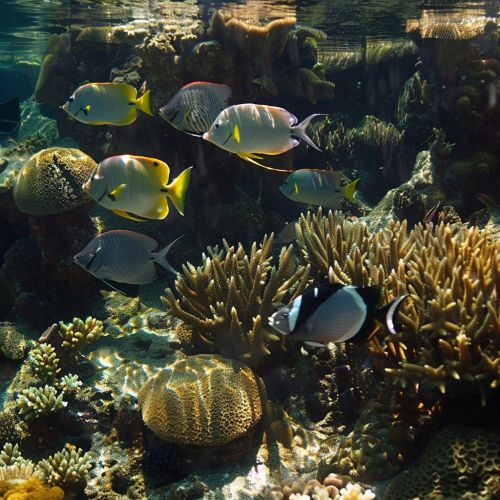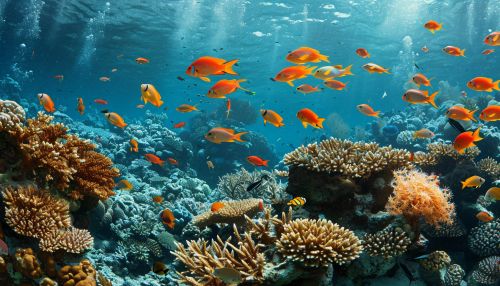Aquatic adaptation: Difference between revisions
(Created page with "== Aquatic Adaptation == Aquatic adaptation refers to the evolutionary process through which organisms develop traits that enable them to live and thrive in water environments. This process encompasses a wide range of physiological, morphological, and behavioral changes that enhance survival and reproductive success in aquatic habitats. Aquatic adaptations can be observed in various taxa, including plants, invertebrates, and vertebrates. <div class='only_on_desktop ima...") |
No edit summary |
||
| Line 3: | Line 3: | ||
Aquatic adaptation refers to the evolutionary process through which organisms develop traits that enable them to live and thrive in water environments. This process encompasses a wide range of physiological, morphological, and behavioral changes that enhance survival and reproductive success in aquatic habitats. Aquatic adaptations can be observed in various taxa, including plants, invertebrates, and vertebrates. | Aquatic adaptation refers to the evolutionary process through which organisms develop traits that enable them to live and thrive in water environments. This process encompasses a wide range of physiological, morphological, and behavioral changes that enhance survival and reproductive success in aquatic habitats. Aquatic adaptations can be observed in various taxa, including plants, invertebrates, and vertebrates. | ||
[[Image:Detail-92467.jpg|thumb|center|Marine life in a coral reef, featuring various fish species and coral structures.|class=only_on_mobile]] | |||
[[Image:Detail-92468.jpg|thumb|center|Marine life in a coral reef, featuring various fish species and coral structures.|class=only_on_desktop]] | |||
=== Physiological Adaptations === | === Physiological Adaptations === | ||
Latest revision as of 10:14, 14 June 2024
Aquatic Adaptation
Aquatic adaptation refers to the evolutionary process through which organisms develop traits that enable them to live and thrive in water environments. This process encompasses a wide range of physiological, morphological, and behavioral changes that enhance survival and reproductive success in aquatic habitats. Aquatic adaptations can be observed in various taxa, including plants, invertebrates, and vertebrates.


Physiological Adaptations
Physiological adaptations are internal processes that allow organisms to maintain homeostasis and perform essential functions in aquatic environments. These adaptations include osmoregulation, respiration, and thermoregulation.
Osmoregulation
Osmoregulation is the process by which organisms control the balance of water and salts in their bodies. Aquatic organisms face different osmoregulatory challenges depending on whether they inhabit freshwater or saltwater environments. Freshwater organisms, such as amphibians and freshwater fish, must prevent excessive water intake and loss of salts. They achieve this through specialized kidney functions and active transport mechanisms in their gills. Conversely, marine organisms, including marine fish and marine mammals, must counteract dehydration and salt accumulation. They possess adaptations such as salt-excreting glands and efficient renal systems to maintain osmotic balance.
Respiration
Respiration in aquatic environments requires specialized structures to extract oxygen from water. Gills are the primary respiratory organs in many aquatic animals, including fish, crustaceans, and some amphibians. Gills have a large surface area and thin membranes to facilitate gas exchange. In contrast, aquatic mammals like cetaceans and pinnipeds have evolved lungs adapted for prolonged dives. These mammals possess high concentrations of myoglobin in their muscles, allowing them to store oxygen and reduce the need for frequent surfacing.
Thermoregulation
Thermoregulation in aquatic environments can be challenging due to the high heat capacity of water. Ectothermic organisms, such as fish and amphibians, rely on behavioral adaptations like seeking warmer or cooler waters to regulate their body temperature. Endothermic aquatic animals, including marine mammals and some fish species like tuna and sharks, have evolved physiological mechanisms to maintain a stable internal temperature. These mechanisms include countercurrent heat exchangers and blubber insulation.
Morphological Adaptations
Morphological adaptations involve changes in the physical structure of organisms that enhance their ability to navigate and survive in aquatic environments. These adaptations include modifications to body shape, appendages, and sensory organs.
Body Shape
Streamlined body shapes are a common adaptation among aquatic animals, reducing drag and allowing efficient movement through water. Fish, cetaceans, and penguins exhibit fusiform body shapes, which minimize resistance and enhance swimming speed. Additionally, flattened body shapes, as seen in rays and flatfish, enable these animals to remain close to the substrate, providing camouflage and reducing exposure to predators.
Appendages
Aquatic organisms have evolved various appendages to aid in locomotion and feeding. Fins are the primary locomotory structures in fish, providing stability, propulsion, and maneuverability. Invertebrates like cephalopods possess specialized tentacles and arms for capturing prey and navigating complex environments. Marine mammals have modified their limbs into flippers, enhancing their swimming capabilities. Additionally, webbed feet in amphibians and some birds, such as ducks and penguins, facilitate efficient movement in water.
Sensory Organs
Enhanced sensory capabilities are crucial for detecting prey, avoiding predators, and navigating aquatic environments. Many fish species possess a lateral line system, a series of mechanoreceptors that detect water movements and vibrations. Cetaceans and pinnipeds have highly developed auditory systems, enabling them to use echolocation for hunting and communication. Additionally, some aquatic animals, like sharks and electric fish, have electroreceptors that detect electrical fields produced by other organisms.
Behavioral Adaptations
Behavioral adaptations involve changes in the actions and strategies of organisms to improve their survival and reproductive success in aquatic environments. These adaptations include foraging strategies, reproductive behaviors, and social structures.
Foraging Strategies
Aquatic organisms employ various foraging strategies to exploit available resources. Filter feeding is a common strategy among baleen whales, bivalves, and some fish species, where they filter plankton and small particles from the water. Predatory behaviors, such as ambush and pursuit hunting, are observed in sharks, dolphins, and octopuses. Additionally, some species exhibit cooperative hunting, where individuals work together to capture prey, as seen in orcas and dolphins.
Reproductive Behaviors
Reproductive adaptations in aquatic environments often involve specialized behaviors to ensure successful fertilization and offspring survival. Many fish species engage in elaborate courtship displays and nest-building activities. Marine mammals, such as seals and sea lions, exhibit polygynous mating systems, where dominant males establish territories and mate with multiple females. Some species, like sea turtles and salmon, undertake long migrations to specific breeding grounds, ensuring optimal conditions for their offspring.
Social Structures
Social structures in aquatic environments can vary widely among species. Cetaceans, such as dolphins and whales, are known for their complex social behaviors and communication systems. These animals form pods and exhibit cooperative behaviors, including alloparental care and coordinated hunting. Similarly, some fish species, like clownfish and cichlids, display social hierarchies and cooperative breeding behaviors. In contrast, many invertebrates, such as jellyfish and crabs, are solitary and exhibit minimal social interactions.
Evolutionary Pathways
Aquatic adaptation has occurred through various evolutionary pathways, resulting in convergent and divergent evolution among different taxa. Convergent evolution refers to the independent evolution of similar traits in unrelated lineages, while divergent evolution involves the diversification of traits within a lineage.
Convergent Evolution
Convergent evolution is evident in the similar adaptations observed in distantly related aquatic organisms. For example, the streamlined body shapes of fish, cetaceans, and penguins have evolved independently to reduce drag and enhance swimming efficiency. Similarly, the development of echolocation in both cetaceans and some bat species represents convergent evolution, as these adaptations allow precise navigation and prey detection in different environments.
Divergent Evolution
Divergent evolution is observed in the diverse adaptations within specific lineages of aquatic organisms. For instance, the various fin shapes and functions in different fish species illustrate divergent evolution, with adaptations tailored to specific ecological niches. Additionally, the diverse feeding mechanisms in cephalopods, ranging from tentacle-based predation to filter feeding, demonstrate divergent evolution within this group.
Ecological Implications
Aquatic adaptations have significant ecological implications, influencing species interactions, ecosystem dynamics, and biodiversity.
Species Interactions
Aquatic adaptations shape the interactions between species, including predator-prey relationships, competition, and symbiosis. For example, the specialized hunting strategies of sharks and dolphins impact the population dynamics of their prey species. Similarly, the symbiotic relationships between corals and zooxanthellae are crucial for the health and productivity of coral reef ecosystems.
Ecosystem Dynamics
The adaptations of aquatic organisms contribute to the structure and function of ecosystems. Keystone species, such as sea otters and beavers, play critical roles in maintaining ecosystem balance through their feeding and habitat-modifying behaviors. Additionally, the presence of apex predators, like sharks and orcas, regulates the populations of other species, preventing trophic cascades and maintaining biodiversity.
Biodiversity
Aquatic adaptations have led to the diversification of life forms in aquatic environments, contributing to the rich biodiversity observed in oceans, rivers, and lakes. The evolution of unique adaptations, such as bioluminescence in deep-sea organisms and the development of specialized feeding structures in filter feeders, has enabled the exploitation of various ecological niches. This diversity enhances ecosystem resilience and provides valuable resources for human societies.
